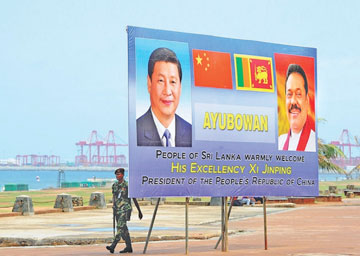|
After Rajapaksa's departure:
Chinese influence wanes
by Bruce Einhorn and Anusha Ondaatjie
To woo the island nation of Sri Lanka, China lent more than US$200
million to fund a new airport built by then-President Mahinda Rajapaksa
near his hometown. It wasn't one of the Chinese Government's better
investments.
 |
|
Billboard welcoming the
Chinese President on his visit to Sri Lanka, in front of the
China-funded Colombo Port City under construction. Pic courtesy:
Bloomberg |
Mattala Rajapaksa International Airport opened in 2013, but two years
later, there is only one scheduled daily flight, on Flydubai.In January,
just after Rajapaksa's reelection campaign ended in an upset loss,
state-owned SriLankan Airlines canceled its flights to the airport.To
gain an edge over rival India, China's leaders have spent years
cultivating the governments of Sri Lanka and other nations in South and
Southeast Asia.
In Sri Lanka, located along the shipping lanes to and from the Middle
East and Africa, China offered about US$5 billion in loans over six
years to fund such projects as a $290 million expressway and a US$360
million port.
In the deal with the highest profile, Rajapaksa embraced a Chinese
plan to invest US$1.4 billion in a new port city to be built on
reclaimed land near the port of Colombo, the capital.
Two visits by Chinese submarines last year highlighted China's
success in elbowing out India.
But the Sri Lanka adventure has since soured. President Maithripala
Sirisena has put the new city on hold, saying the government needs to
investigate whether the Chinese-backed project violated rules protecting
the environment and preventing corruption.
"China discounted the possibility of regime change," says Deshal De
Mel, senior economist at Hayleys, a Sri Lankan conglomerate.
The airport that was so closely associated with Rajapaksa "is one
example of a project they may have thought twice about financing."
China's rivals have rushed to capitalize on Beijing's unpopularity
with the new government. Both India and the US had a stormy relationship
with Rajapaksa, who crushed a decades-long rebellion by the Tamil
minority in 2009. India, which has a large Tamil population, and the US
supported a campaign to have the United Nations Human Rights Council
investigate alleged war crimes by the Rajapaksa regime. The Chinese
offered Rajapaksa military and diplomatic assistance during the war.
Sri Lanka's new government, which pledges to honour term limits and
work closely with Parliament, has been mending ties with New Delhi and
Washington. The nation's overtures paid off when US Secretary of State
John Kerry traveled to Colombo on May 2, the first visit by a US cabinet
member in a decade. He praised the government's commitment to democracy.
"The United States," he said, "wants to work with Sri Lanka."
In March, Indian Prime Minister Narendra Modi visited, the first trip
by an Indian leader since 1987, and emphasized the cultural and
religious links between the countries. Modi prayed at a Buddhist temple
that has a tree said to descend from the one under which the Buddha
attained enlightenment.
He unveiled plans to help fund power plants and railroads. During the
visit, the two sides agreed on a US$1.5 billion currency swap that would
moderate volatility in Sri Lanka's rupee.Modi's "deft diplomacy" helped
wean Sri Lanka away from China, Kadira Pethiyagoda, a visiting fellow in
Asia-Middle East relations at the Brookings Doha Center, wrote in a May
1 column. The setback should teach China, wrote Pethiyagoda, "that its
'tried and true' " tactics of commercial trade and military aid cannot
succeed on their own.
Yet Sri Lanka needs infrastructure, and China has more money than
India. Sri Lanka has signed on as a founder of the Chinese-backed Asian
Infrastructure Investment Bank, which is based in Beijing and designed
to compete with the World Bank.
"Even India is going to China for financing," says Dushni Weerakoon,
deputy director of the Institute of Policy Studies in Colombo.
"I don't think China is just going to pack up and walk away," says
Sarah Graham, a lecturer in foreign policy at the University of Sydney.
While Sirisena has shown less interest than Rajapaksa in a close
partnership, "the Chinese will gladly engage with Sirisena's
administration."
The countries are "in the final stage" of talks on a free-trade pact,
China's official Xinhua News Agency reported on April 21. Sirisena
hasn't unfrozen the new city project, but China still hopes it can be
"pushed forward steadily," Foreign Ministry spokeswoman Hua Chunying
said at a May 6 press conference. Sri Lanka's Board of Investment says
the city project is undergoing environmental studies. It didn't rule out
a role for China.The experience with Rajapaksa should be a learning
moment for Chinese leaders, says John Lee, senior fellow at the Hudson
Institute in Washington. Developing strategic partnerships "is not
something they're very practiced at, to be frank," he says. "They will
get better."The bottom line: Despite offering $5 billion in project
financing to Sri Lanka, the Chinese have seen their influence there
diminish.
-Bloomberg |

